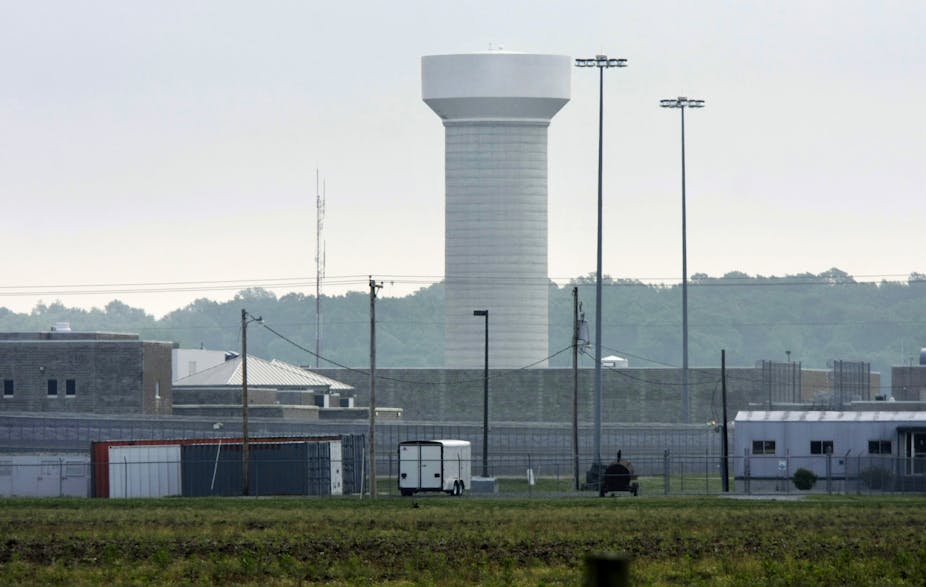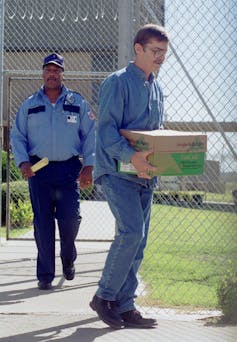
John M. Eason ne travaille pas, ne conseille pas, ne possède pas de parts, ne reçoit pas de fonds d'une organisation qui pourrait tirer profit de cet article, et n'a déclaré aucune autre affiliation que son organisme de recherche.
Texas A&M University apporte des fonds en tant que membre fondateur de The Conversation US.
Voir les partenaires de The Conversation France

The election of Donald Trump signals an end to the recent optimism about reducing the mass imprisonment of two million U.S. citizens each year.
Trump supports policies like the immigrant ban and increased stop-and-frisk that will undoubtedly lead to more arrests and strain an already bloated prison system.
After taking office, Trump signed an executive order authorizing the secretary of homeland security to “allocate all legally available resources to immediately construct, operate, control, or establish contracts to construct, operate, or control facilities to detain aliens at or near the land border with Mexico.”
It seems clear that more American prisons are on the way.
While much has been written about mass incarceration, less is known about the prison building boom and the role it plays in slowing reform of the criminal justice system.
As I explain in my book, “Big House on the Prairie,” the number of prisons in the U.S. swelled between 1970 and 2000, from 511 to nearly 1,663. Prisons constructed during that time cover nearly 600 square miles, an area roughly half the size of Rhode Island. More than 80 percent of these facilities are operated by states, approximately 10 percent are federal facilities and the rest are private.
The prison boom is a massive public works program that has taken place virtually unnoticed because roughly 70 percent of prisons were built in rural communities. Most of this prison building has occurred in conservative southern states like Florida, Georgia, Oklahoma and Texas.
Much of how we think about prison building is clouded by the legacy of racism and economic exploitation endemic to the U.S. criminal justice system. Many feel that prison building is the end product of racist policies and practices, but my research turned up a more complicated relationship.
People of color have undoubtedly suffered from the expansion of prisons, where they are disproportionally locked up, but they have also benefited.
Blacks and Latinos are overrepresented among the nation’s 450,000 correctional officers. Prisons are also more likely to be built in towns with higher black and Latino populations. Many may be surprised to learn that residents of these often distressed rural communities view local prisons in a positive light.
In 2007, I moved my family to Forrest City, Arkansas, a majority black town that welcomed a federal prison in 1997.
My hope was that by studying this one town I would gain greater insight on key questions: Why is America building so many prisons? Why now? And why in rural areas?
I quickly learned Forrest City choose to build a prison not simply in hopes of landing jobs or creating economic well-being, but also to protect and improve its reputation.

Hosting an institution like a prison may not seem image-enhancing, but it makes sense in Forrest City. During the early 1980s, this town of roughly 13,000 gained national infamy that has been difficult to escape. A sordid tale that unfolded here – involving rape, castration, arson and violent protest – was chronicled on the TV news magazine “20/20” and in newspapers, and eventually became the subject of a book called “Unequal Justice.”
My own book examines the ways the prison economy takes shape and operates in towns like Forrest City. It provides a view into decision-making meetings and tracks the impact of prisons on economic development, poverty and race.
In Forrest City, support for the prison united the otherwise racially divided town.
Buddy Billingsly, a member of a prominent white land-owning family, saw the prison as a way to create jobs and new revenue for local utilities.
Many African-Americans in town believed that reducing racial disparities in mass imprisonment is a moral imperative, yet they supported building the prison. The late Coach Cecil Twillie, a prominent black leader in Forrest City, explained “he didn’t want his town to end up like Gary.” Gary, Indiana became the murder capital of the country and a symbol of urban blight during the 1980s.
Mayor Larry Bryant, formerly the local chapter president of the NAACP, also threw his support behind building the Forrest City Correctional Facility.
Because rural communities have grown increasingly dependent on prisons, they will not be easily convinced to give them up. My research shows that for many struggling rural communities plagued by problems most associate with urban neighborhoods – poverty, crime, residential segregation, deindustrialization and failing schools – prisons offer a means of survival. Prisons provide a short-term boost to the local economy by increasing median family income and home value while reducing unemployment and poverty.
This survival instinct may explain why communities that have prisons are opposed to legislation like sentencing reform that would reduce the number of prisoners locked up in America.
Reforms like repealing three strikes are vital to reducing the number of people imprisoned. The Sentencing Project estimates that without sweeping sentencing reform it would take almost 90 years to return the prison population to its 1980 level.
Supporting a large number of prisons housing millions of inmates is expensive. In 2014, states spent US$55 billion on corrections, meaning the economic benefits to towns come at a high cost to taxpayers.
It doesn’t look like the footprint of prisons will be shrinking any time soon. Given our current political climate, it’s more likely we will see more prisons built.
Weaning rural communities off the prison economy will mean considering alternative investment strategies like green industries. If we do not provide creative alternatives to depressed rural communities, we stand little chance in reducing their over-reliance on prisons.